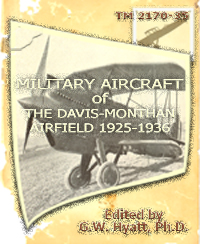|
"General Arnold sent for me and I came to Washington and was on his staff. One of the first jobs he gave me was to prepare for the Tokyo Raid. I went there in December, 1941, to Washington, and January, 1942, he called me in and gave me this chore."
J.H. Doolittle, Oral History, 1960
J.H. Doolittle, Date & Location Unknown (Source: SDAM)
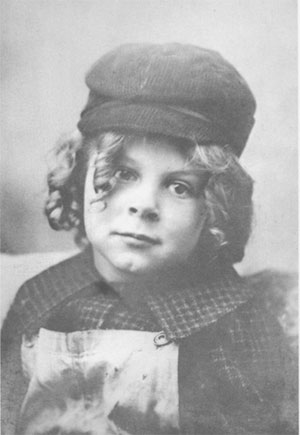 |
Photograph, right, courtesy of the San Diego Aerospace Museum Flickr Stream (SDAM). It shows Doolittle at an early age, with the only worry being how to keep his hair out of his eyes.
What can be written about Jimmy Doolittle that hasn't already been written. Anyone of a certain age who was alive and halfway warm during the 20th century knows who he is. If you are not of a certain age, read on, because Doolittle is someone you should know.
There are numbers of biographical sketches and photographs of Doolittle on the Web. As of the upload date of this page, a search for "James Harold Doolittle" yields over 4,000 leads. One I recommend is at the official U.S. Air Force Web site. A video featuring him from the San Diego Aerospace Museum is at the link. In the video we find Doolittle enumerating some of his record flights and describing others that contributed to the development of aviation during the Golden Age.
J.H. Doolittle, Date & Location Unknown (Source: NASM)
 |
On this page, I do not reiterate those sites, or the numerous books that have been written about his military leadership or Golden Age racing successes. Rather, I describe his visit at Tucson and provide a couple of examples of his flying exploits as a civilian pilot.
Oakland Tribune, December 22, 1918 (Source: Tribune via Woodling)
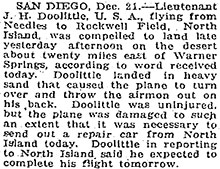 |
When all is said and done, Doolittle made his marks in aviation in war and in peace. During WWI he learned to fly at Rockwell Field, was ordered overseas but did not get there due to a shortage of aircraft. He was sent back to Rockwell Field and finished the war as an instructor in aerial gunnery and combat. During this time, about six-weeks after the end of WWI on November 11, 1918, we find him in the news citing a minor incident in a cross-country flight. At right is an article from the Oakland Tribune of December 22, 1918 describing the context of the incident. Thanks to Guest Editor Bob Woodling for researching and sharing the article.
Boeing PW9A Similar to Doolittle's (Source: Webmaster)
 |
Among other things, he led the first aerial attack on the Japanese mainland at the beginning of WWII. He was a premier Golden Age record setter, racer and corporate pilot.
He visited with us at Tucson late in his first Army career. We see him during an instant when he landed solo at Tucson Sunday, October 9, 1927 at 8:45 AM. Based at Dayton, OH, Wright Field, he was eastbound from San Diego, CA to El Paso, TX. He stayed on the ground 35 minutes. He was flying Army 26-456, a Boeing PW9C. At right is a PW9A, from page 10 of the military aircraft book by your Webmaster cited in the left sidebar. According to Joe Baugher's site, 26-443 through 26-457 were all Boeing PW-9Cs serial numbers 837-851.
We can speculate on the reason for Doolittle's flight through Tucson. The National Air Races (NAR) for 1927 were held at Felts Field, Spokane, WA. Doolittle attended the event and performed an aerobatic exhibition on behalf of the Army. It could be that he was returning east to Dayton after the NAR, which were held the week of September 21-25. The juxtaposition of Doolittle's signature in the Register with a couple of other pilots who participated in the NAR (Casey Jones, Jay Sodowsky), each heading east at about the same time, is further evidence.
Doolittle was born on December 14, 1896. He flew West on September 27, 1993. The following short biography appears on the Arlington National Cemetery Web site. Mike Gerow notes that Doolittle's date of graduation from UC Berkeley was 1923, not 1922. The Oakland Tribune of May 16, 1923 corroborates this date (headline: "Largest Class in History of University is Graduated"). All the students (Doolittle is in the third column of the article about 2/3 of the way down the page) are listed, "to whom the degree of bachelor was awarded." There is no mention of whether the degree was B.A., B.S. or A.B. His bachelor's degree was in mining/geology (B.S.) and he studied under the most famous geologist of his day, Andrew C. Lawson.
James Harold Doolittle, General, United States Air Force. Born at Alameda, California, on December 14, 1896, Doolittle was a junior at the University of California when the United States entered World War I. He enlisted as a flying cadet in the Army Signal Corps, which gave him a commission. He spent the war as a flying instructor in the United States.
Remaining in the Army after the war, he earned a B.A. degree in 1922 and then studied aeronautical engineering at the Massachusetts Institute of Technology, from which he received both a Masters and Doctors degree in science. He took a leave of absence from the Army in the period before World War II, but returned to active duty when the war began.
He was awarded the Medal of Honor, and was promoted from Colonel to Brigadier General for leading the first carrier-based bomber attack on mainland Japan in 1942. His citation, presented personally by President Franklin D. Roosevelt, reads, in part: 'With the apparent certainty of being forced to land in enemy territory or perish at sea, Colonel Doolittle personally led a squadron of Army bombers, manned by volunteer crews, in a highly destructive raid on the Japanese mainland.' General Doolittle died in California on September 27, 1993 and was buried in Section 7-A of Arlington National Cemetery, with his high school sweetheart, Josephine Daniels Doolittle (May 24, 1895-December 24, 1988)."
|
 |
Through his military career, besides the Medal of Honor (ribbon at left), Doolittle received the Distinguished Service Medal twice, the Silver Star, Distinguished Flying Cross three times, the Bronze Star and the Air Medal four times.
In 1930, Doolittle resigned from the Air Corps and joined the Shell Oil Co. Shell was very interested in sponsoring flights and personal appearances, because it was a good thing to do for business. Notably, fellow Register pilot E.E. Aldrin performed a similar role for Standard Oil of New Jersey. Resigning did not stop him from being decorated. One of the first things that happened was the following found in Popular Aviation (PA) magazine, March, 1931.
Doolittle Decoration, Popular Aviation, March, 1931 (Source: PA)
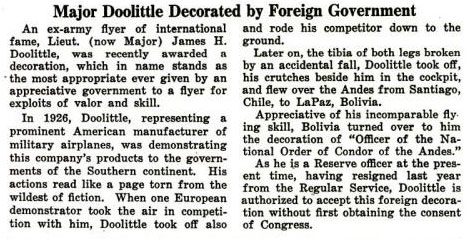 |
Likewise, his departure from the military did not preclude excitement. Below, from Popular Aviation magazine, September, 1931, is an adventure early in his career with Shell. An additional article in Popular Aviation, November, 1933, alludes to this parachute jump, and documents Doolittle's experiences as a Golden Age test pilot. The article is at the link (PDF 2Mb). His explanations of early test flying are at once exciting and shocking, in that the early process of testing, tweaking and testing again seems very dangerous. Today, test flying a new design is done with simulators, and the bugs are worked out long before any new airplane is ever flown for the first time. The last line of his article is testimony to the guesswork and the resulting danger: "But I have yet to hear of the first case of anyone engaged in this work dying of old age." The article is a worthwhile read.
Doolittle Parachute Jump, Popular Aviation, September, 1931 (Source: PA)
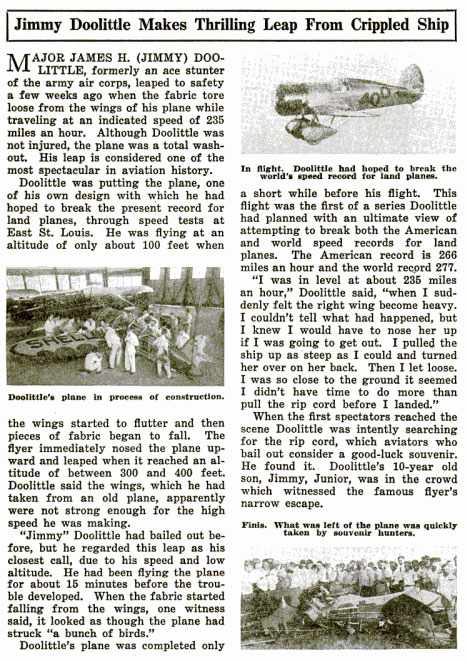 |
A useful reference is an oral history Doolittle recorded in 1960 at Columbia University. The complete interview is available as a PDF transcript at the link. It is a good read. When he first went with Shell, his primary chore was to develop and sell aviation products. A secondary chore was to bring favorable publicity to Shell flying a Shell airplane, being the Shell pilot, and using Shell products (to this day Shell manufactures and sells aviation petroleum products). One example of a publicity flight is below. Shared by site visitor Jeff Staines, is a postal cachet "signed" by Doolittle on May 16, 1932.
J.H. Doolittle, Postal Cachet, May 26, 1932 (Source: Staines)
 |
Mr. Staines says about his cachet, "... it is a rubber-stamped autograph of James H. Doolittle. As autographing airmail covers back then was in vogue, and sometimes many hundreds were sent to one aviator at a time to sign, some enterprising souls had a rubber-stamp facsimile of their signature made,and with their permission, used in lieu of a pen. This cover denotes the appearance of Jimmy Doolittle at the 1932 National Exchange Club convention at St. Charles, MO. The N.E.C. promoted service to aviation during the Great Depression, and many noted pilots were called on as guest speakers. Just a few months later, Doolittle won the 1932 Thompson Trophy Race with the famous Gee-Bee R-1, rated the world's most dangerous race plane."
Below, from site visitor Joe Kranz, is a photograph and postal cachet straight from his grandfather's three-hole punched album. The cachet and stickers commemorate the 1932 National Air Races (NAR) at Cleveland. This was the year Doolittle took the Thompson Trophy Race flying the Gee Bee R-1. That airplane (NR2101) can be seen over his shoulder in the photograph. Please direct your browser to the airplane's link to learn about the mix and match history of his Gee Bee.
Postal Cachet and Photograph, Jimmy Doolittle, September 4, 1932 (Source: Kranz)
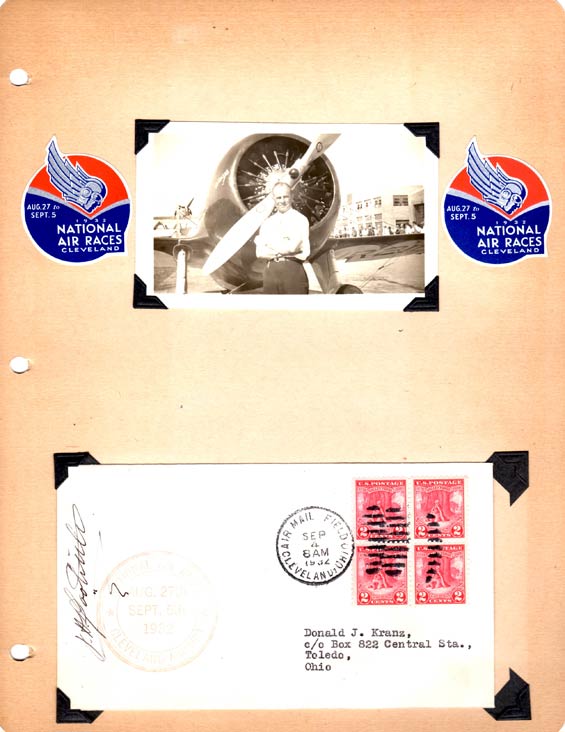 |
Another example was a more ambitious flight executed a couple of months later and documented both in his oral history and by the following cachet shared by Mr. Staines.
J.H. Doolittle, Postal Cachet, July 25, 1932 (Source: Staines)
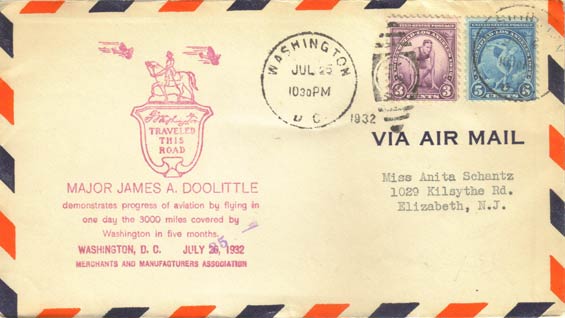 |
Mr. Staines describes this one as a, "... George Washington birthday bicentennial flight commemorative cachet that Doolittle flew for Shell Oil Co. on July 25, 1932, to promote advances in modern travel. The flight covered 3000 miles over as many routes traveled by George Washington as was possible to fly over in a single day, dawn to dusk. Doolittle's travel time was about 17 hours."
From the oral history,
Q: Who conceived of that George Washington route for the airmail?
Doolittle: I believe it was either the George Washington Society or a relative or descendant of George Washington who flew with me on the flight and was a member of the Society. We endeavored to fly over practically the entire route covered by George Washington in his life, in one day; I think we flew 17 hours that day. |
J.H. Doolittle, George Washington Flight, July, 1932 (Source: Staines)
 |
At right, also shared by Mr. Staines, is a Shell advertisement that celebrated the George Washington flight.
Commercially for Shell, Doolittle was responsible for promoting 100 octane aviation fuel. To achieve that octane rating, an additive, tetraethyl lead, had to be added. Doolittle had an experience with tetraethyl lead that he cites in the oral history.
As part of his good will record flying for Shell, he also embarked on a three-country flight. Below, he states in his oral history,
"I made the first flight tying together the three capitals of Canada, the United States and Mexico. This was 1932. I took off from Ottawa, flew to Washington, then on down to Mexico City. This was a fairly interesting flight for two reasons. In the first place, when I got to Washington the weather was very bad and I had trouble landing there. The second trouble was that in those days, with a high compression engine such as I had, you could not buy gasoline anyplace, and so I carried a little can of tetra-ethyl-lead, about that big, in back of my seat. In flying over the mountains, coming in to Mexico City, I had to go up about 18,000 feet, and I began to feel real goofy. I began to feel so goofy that I couldn't understand it, because at this altitude the altitude shouldn't have bothered me. But I began to feel that I was passing out, so I began to consider whether I should get out of the airplane. There was no place to land, I was right over the most jagged mountains of that range, coming in from Tampico to Mexico City. But I thought, if I pass out I'll surely crash, so as soon as I can't answer a simple question, I'll jump.
"So I would say to myself, 'What year did Columbus discover America?' '1492.' 'What year was I born?' and so forth--'How much is 13 x 13?' As soon as I couldn't answer a question, I was going to jump. However, I did get over the mountains, get down lower, and get in to Mexico City before I passed out. I landed there very sick and regurgitated almost as soon as I got out of the airplane. I didn't know until the next morning what was the matter. This little can of tetra-ethyl-lead had burst, and the tetra-ethyl-lead, which is extremely toxic, had gone all through the airplane. I was sick for several days. Had I not been in such excellent physical shape, I would have had serious trouble."
|
Another photograph of Doolittle taken September 2, 1936 is at the Klein Archive on this site.
 |
Further along in the oral history, Doolittle states about 100 octane fuel, "That was perhaps the biggest commercial gamble, but there are various types of gambles. I don't think that any commercial gamble can be as great as a gamble with your life, and I don't believe that any gamble with your life can be as great as a gamble with your good name. As far as a commercial gamble was concerned, yes, that was a gamble, because I believed that there was a future for 100 octane fuel, but there were then no engines to use it, and it was like the hen and the egg, which came first? If you waited for engines to be developed for 100 octane fuel, they'd never be developed, because there'd be no fuel for them. So I felt that we had to go ahead with the fuel and make the fuel available, and when the fuel was available at a reasonable price, I felt that there would be enough engines developed that required it so that it would be a profitable venture. This turned out to be true, but it was a gamble. However, a commercial gamble is the least of all gambles."
In 1991, Doolittle published his autobiography (cover, left), a very readable account of Golden Age aviation and beyond. Numerous Register pilots are mentioned throughout his book, but little is said about their accomplishments. Doolittle's oral history reveals why, "The aviation fraternity was small, and we all knew one another. They were all fine people. Anecdotes about them -- that just isn't my line, -- I'm a technical man, not a literary man. I don't recall anything that would be of interest."
---o0o---
As a footnote to this page, I quote below from the 1960 oral history. These quotes give special insight into Doolittle's WWII commands.
"Q: The Tokyo Raid is on the record, but could we talk about it from your personal point of view?
"Doolittle: When the idea was first suggested, it came, I believe, from Captain Lowe of the Navy. He discussed the idea with Admiral King, Admiral King discussed it with General Arnold, and General Arnold called me in to implement it. So it was not my idea. The implementation required the study of aircraft to determine which aircraft, which airplane was the most suitable for the job, the modification of the aircraft, and the training of the crews. By the time this was half done, I realized that it was to be a carrier operation, and being a carrier operation, I had a very good idea what it was going to be. I then requested permission to lead the flight, telling General Arnold that I knew more about it than anyone else, I had trained the crews and modified the aircraft and I knew more about the people and equipment than anyone else, and I would like to lead it. And he let me lead it. [this REFERENCE describes the raid as in the image, below, right].
"Q: What were the crucial moments of the raid?
NAVWEPS, page 92, April 18, 1942 (Source: Webmaster)
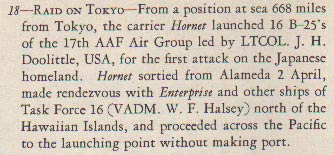 |
"Doolittle: Well, the first crucial moment was when our government asked the Russians to permit us to land at Vladivostok. This would have made the flight very easy. It would have shortened the distances, given us a prepared landing field and friendly territory to land on-- would have made the flight very easy. The Russians refused. The next decision that had to be made was where we would go in China. We decided to go to the little town of Chu-Cho, which had a prepared flying field. We then asked the Chinese if we could go, and Chiang Kai-Shek was not anxious at all to have us go, because he felt there would be reprisals from the Japanese and that China would suffer for that flight. It was decided that we would go anyhow, and as a matter of fact his permission was not asked until the thing had gone so far that it was practically impossible to call it off. The flight was made, and when we were ready to land at Chu-Cho, we found that the weather was bad. Chu-Cho lay in a little valley between mountains, and the homing device that was supposed to tell us where the field was did not answer. This was the most critical point, I guess, when we found we would all have to either crash land or jump. We found out later that the airplane bringing the homing device and our supplies in and people to run it had crashed and all aboard were killed, and the little homer was lost. So when we arrived that night in bad weather, it was impossible to land at our destination.
"The weather, of course, when we took off, was very rough. None or us had ever taken off from a carrier before. That, however, was good -- the fact that the weather was rough -- because there was a strong wind blowing, and the only worry we had was that we might have to take off in a dead calm. If so, then it would have been very difficult to get airborne with the very heavy load that we had. So we were delighted to have a rough sea and plenty of wind. Each plane had a target, and the target maps were distributed as soon as we put out to sea in the Hornet, and each crew made a very complete study of the target area and all of the terrain in that vicinity, so that we could find each target readily, bomb it promptly, and get out rapidly. My target was a military plant more or less in Tokyo. Each one of us had our own target. We went in low, dropped our bombs, then stayed on the deck and got out to sea as quickly as we could. After getting out to sea, we turned half right and went to China.
"There was moderate flak, moderate inaccurate flak. The flak was not intense. None of the planes were shot down, though many of them had hits. The fighters chased some of the planes, but none of the planes were shot down by the fighters. In my own case, I saw five fighters converging on me, and there were two little hills. I swung very quickly around the hills, did an S turn, and the fighters turned also but they didn't make the second half of my S, and the last I saw was the fighters going off in the opposite direction, apparently trying to pick me up, not having seen me make the other side of the S turn. So I did not get shot at by fighters, and it was only this one group of fighters that
actually formed and were preparing to attack.
"Q: When you reached China and landed, you felt you had not succeeded in your mission?
"Doolittle: I was very distressed. I realized that we had accomplished the first part of our mission, which was to bomb Japan, but I felt very distressed because the second part of our mission was to collect our aircraft and make them available to the CBI people, and I was sure when I got to China that we would all lose our aircraft, because when we got to the coast there was dense fog and we all had to climb up into the fog. We had two airplanes that crash-landed right near the coast, in the water. So the likelihood or saving the aircraft was remote or nil, so I felt very badly about having lost my entire force of aircraft and having scattered my entire force of men over a considerable area of China.
"Two men were killed in one crew, but the other eight were picked up by Japanese, tried, and three of them were executed. One was starved to death. The other four we got back, after the war was over. They were in very bad shape. One of them we couldn't move for six weeks. He just had to be fed until he could get strength enough. He could be moved off his bed, that's all. Another man was killed when he jumped.
"The raid had three advantages, really. The first advantage was to give the people at home a little fillip. The news had all been bad until then. The second advantage of the raid was to cause the Japanese to worry and feel that they were vulnerable, and the third and most useful part of the raid was that it caused a diversion of aircraft and equipment to the defense of the home islands which the Japanese badly needed in the theatres where the war was actually going on. The actual damage done was minimal. When you think that we had sixteen airplanes with one ton
of bombs each -- sixteen tons or bombs -- and in the late raids they were dropping 5,000 tons of bombs in one raid 16 against 5,000 is pretty puny."
---o0o---
After Doolittle came back from Japan, Arnold told him there was to be an invasion of North Africa.
Arnold said, "'General Patton is in charge of it, he's looking for an airman -- would you like to do it?'
'Yes.'
'Then go and talk to General Patton.' General Patton and I had a good talk and hit it off very well together. We reported to General Arnold and General Marshall that we would like to work together, and Arnold and Marshall said, 'Both of you go over and see General Eisenhower,' who was then in charge at London. We went over and saw General Eisenhower, and the operation grew. Instead of being just a small operation on the west coast of North Africa, it became a large joint British-American operation with landings in the Mediterranean and on the west coast. I ended up as General Eisenhower's senior -- General Eisenhower was then chosen to command the whole thing
and I ended up as his senior American airman for the North African campaign."
"Q: Did you and General Eisenhower fail to see eye to eye at one point?
"Doolittle: General Eisenhower of course was very anxious that I should be his staff officer, and I was much more interested in running a command and also in doing a little flying. On one occasion he called me in and said that he had tried to get me the day before, 'Where was I?'
'I was up flying,' I told him.
"He said, 'It takes a major general to command the 12th Air Force. Any second lieutenant can go up
and fly and shoot down Germans. You can either be in command of my 12th Air Force, or you can
be a second lieutenant and shoot down Germans, whichever you want to do.'
"I think after that we had a perfect understanding."
---o0o---
"I can sum my career up in a word: I've been real lucky!"
J.H. Doolittle, Oral History, 1960
---o0o---
Dossier 2.2.71
THIS PAGE UPLOADED: 02/22/11 REVISED: 06/28/11, 04/10/14
|

